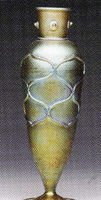|
Colorful, Early Steuben Glass Can Be Affordable
By Anne Gilbert
Steuben glass, like other early 20th century crystal, keeps going up in
price. But surprisingly, many items attributed to founder Frederick Carder offer
possibilities for a beginning collector. This is especially true when the items
are examples of his varied techniques using color. At auction, small pieces can
range in price from $300 to $1,000.
When Frederick Carder founded Steuben in
early 1903, he created and pioneered many new methods using colored glass, much
in the 4 Art Nouveau style. Collectors can specialize in a single technique,
design or category (from vases and lampshades to bowls and goblets). His
influence and work lasted until 1918. He named it and designed everything
from the products to the factory and furnaces.
During the early Carder years,
the emphasis was on color. From the 1920s, the company became concerned with
form, engraving and accenting the brilliance of the crystal. The latter was a
trend begun after World War I with such Swedish glass companies as Orrefors and
Kosta. Fortunately for the collector, Carder was a great experimenter, as were
Louis Comfort Tiffany, Emile Galle' and other glass designers of the era. His
imaginative use of materials was matched with such exotic names as Gold Aurene,
Verre de Soie, Tyrian and Intarsia.
Carder considered Intarsia his greatest
achievement. Most was made in the 1920s and '30s. A design in colored glass was
enclosed between two layers of crystal, and the total thickness of the three
layers was less than one-eighth of an inch. All of the pieces made for sale and
not just experiments have a facsimile signature, "Fred'K Carder" engraved on the
side of the piece.
CLUES: Paper labels used on Verre de Soie and other pieces
have long since disappeared. On some of the acid cut back pieces, the Steuben
fleur-de-lis was marked before the piece was placed in the phosphoric acid. They
are near the base on the side. However, many have no marks. Other marks are the
fleur-de-lis stamped or the word "Steuben" in block letters.
Carder's Gold
Aurene has a similarity to Tiffany gold. However, specialist collectors say it
has more depth, uniformity and richness. Others such as Blue Aurene can confuse
a collector due to their similarity. The earliest Gold Aurene pieces have a
purplish cast while later examples often have reddish shadings. Collectors
should be on the lookout for the Gold Aurene vases decorated with leaves and
vines of green glass, made in limited editions.
Be wary of pieces that at
first glance look like Steuben or those with Carder or Steuben signatures that
don't seem Steuben quality. During the 1960s and '70s, anyone with access to a
dental drill could and did sign those two names on similar pieces. Buying them
on eBay can be iffy.
Entire table services were often designed by Carder for
individuals. They usually combined family crest, personal monograms and a coat
of arms with a specially designed pattern. Among the pieces included might be
drinking glasses and finger bowls as well as candlesticks or other decorative
pieces.
During the 1920s, Carder designed acid-etched pieces including
tableware, vases, bowls and lighting fixtures. Most were of cased glass with a
darker colored glass covering a light inner layer. Some combinations used Gold
or Blue Aurene cased over Alabaster, Pomona Green or Jade Yellow. Plum Jade used
a three-layered color combination.
For more information and catalogs, check
museum bookstores and the Corning Museum in Corning, New York.
|

Steuben blue Aurene atomizer. (Photo, James Julia Auctions, Fairfield,
ME)

Steuben decorated vase with gold Aurene finish. Signed on the underside
"Aurene". |